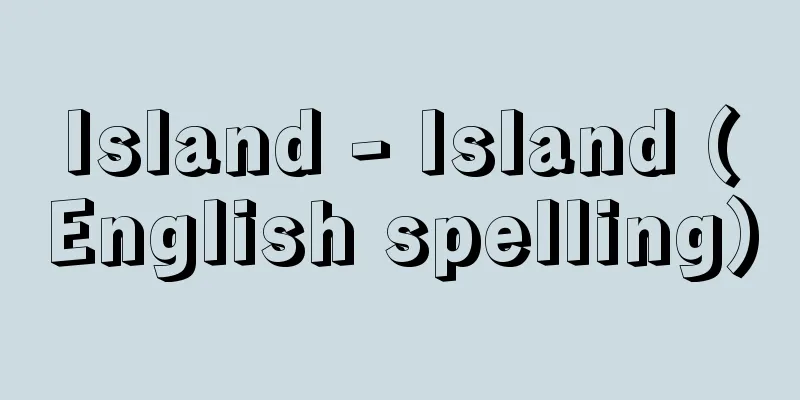Island - Island (English spelling)

|
A landmass that is completely surrounded by water (sea, lakes, rivers, etc.) and is smaller than Australia, the smallest continent. The size of the mainland and the island is relative. For example, Honshu, Japan, is the seventh largest island in the world, but in terms of Japan's land area, it is one of the mainlands, and the four main islands are about 3,300 islands. [Masami Ichikawa] ClassificationIslands can be classified into several categories based on their distribution and origin. In terms of distribution, islands can be divided into islands, archipelagoes, archipelagoes, and isolated islands. Generally, islands that are distributed in large numbers and over a large area are called islands, islands that are distributed in a relatively small area are called archipelagoes, islands that are arranged in a row are called archipelagoes, and islands that are distributed in isolation from others are called isolated islands. However, with the exception of isolated islands, these are relative categories and do not necessarily fall into the above categories, and some names are largely conventional. According to the origin of islands, they are divided into continental islands and oceanic islands. Continental islands are composed of the same geological structure and materials as continents, and are often remnants of former land that has sunk below sea level. They are located between the andesite line and the continent. Oceanic islands formed geologically independent of the continents, and are volcanic islands and coral reef islands. These two major classifications based on origin were proposed by A. R. Wallace from a biological standpoint, and were later adopted by geologists. Examples of continental islands include Newfoundland and Vancouver Island in Canada, Great Britain in the UK, and Japan, but these are separated from the continents and the sea between them is not very deep. Other continental islands are formed by the accumulation of sediments on the continental shelf, such as Long Island in New York, which was formed by glacial moraine. Furthermore, some islands, such as the Bahamas in Central America and the West Indies, were formed by the deposition of marine shells and chemical components. Others, such as coastal provinces, were formed when sand was carried and deposited by waves. Mangrove islands, which form at the mouths of shallow, quiet rivers in warm temperate regions, gradually grow larger as mangroves, an evergreen tree unique to the tropics, grow and become islands. There are also channel islands, where sand accumulates at the mouths of rivers, forming deltas, and some are surrounded by the water surface of the river and become islands with lush vegetation. Good examples of ocean islands are Iceland and the Hawaiian Islands, which were formed by the eruption of underwater volcanoes, and the ridges where those volcanoes are located have never been part of a continent. Also, among coral reefs, atolls (attols) are the most typical type of ocean island, but ice packs in the Arctic Ocean and the Southern Ocean can form large islands, which are specifically called ice islands. [Masami Ichikawa] Flora and faunaAn island's natural flora and fauna naturally represents those plant and animal species that have been able to migrate across bodies of water from the nearest continent, but there are fewer species present on the island than in geographically similar continental areas. This is called "biodepletion." Island species often evolve independently of similar continental species and form discontinuous populations. [Masami Ichikawa] Geographical characterThe distance of an island from the mainland determines its proximity or isolation from the mainland, and greatly influences its geographical character. In terms of biogeography, some islands show distinctive distributions of life on the mainland, with species that became extinct on the mainland being preserved for a long time and new species emerging. Furthermore, many islands have interesting characteristics, with their isolation from the mainland reflected in racial, ethnic and even folk traditions. In countries close to the continent, such as Japan, the United Kingdom, the Aegean islands, and Indonesia, cultural exchanges with the continent have been taking place since ancient times, and at the same time, there have been political negotiations with the continent. There have been cases where these countries have been at war with the continent or been colonized, but on the other hand, there have also been cases where they have avoided colonization because they were isolated from the continent. Islands far from the mainland are generally called remote islands, and many of them have been slow to develop and have been left behind in cultural progress. Due to limited land area and limited resources, many of them have a large population composition, especially among young people, with a large elderly population. On the other hand, some islands, such as Hatsushima in Izu, have made arrangements such as equal division of arable land and restrictions on the number of households to curb overpopulation. Some islands are strategic locations equivalent to foci or crossroads of global transportation, such as the Hawaiian Islands and Singapore Island. Many of these islands have developed seaports and fishing ports, or are home to military ports, but many of the ports are underperforming due to their remoteness from the market. [Masami Ichikawa] developmentMany islands far from the mainland have unstable transportation links to the mainland and lack resources, which indicates their backwardness. The development of remote islands has only been actively undertaken in recent times, with the Remote Islands Aviation Development Act coming into force in 1952 (Showa 27) and the Remote Islands Development Act coming into force in 1953. Initially, 45 islands were designated as targets of the Remote Islands Development Act, but as of the end of March 2017 (Heisei 29), 258 islands are now subject to this law. An isolated island is an island that is isolated from other islands or from the mainland and has very little connection to them. A symposium on isolated islands was once held at the Science Council of the Pacific, and since then it has been taken up as an important international topic, with research being conducted in the fields of geography and sociology. The current state of isolated islands and the results of development measures for them are attracting great interest from all quarters. [Masami Ichikawa] Island FolkloreThe expectations placed on islands in the Japanese folklore community were very strong and early on. For example, predecessors such as Kunio Yanagita, Shinobu Orikuchi, and Keizo Shibusawa often visited Okinawa and other islands, and spoke of the importance of islands. In 1921 (Taisho 10), Yanagita toured the Amami and Okinawa islands, and wrote "Hainan Shoki." In 1933 (Showa 8), he worked on editing the magazine "Shima" with Shuncho Higa, who was from Okinawa, and poured extraordinary passion into islands. In 1937, Yanagita began a survey of sea villages, which included many islands. Furthermore, in 1950 (Showa 25), under his guidance, the Folklore Research Institute conducted a survey of remote islands. Shibusawa also paid attention to islands early on, and had people from the Attic Museum (now the Kanagawa University Institute of Japanese Folk Culture), which he presided over, conduct a survey of remote islands. It was at his suggestion that the Eight Societies Union (which became the Nine Societies Union the following year in 1951) began a joint survey of Tsushima Island in Nagasaki Prefecture. After Tsushima, the Nine Societies Union also conducted joint surveys on the islands of Amami, Sado, and Okinawa. The reason why islands were considered so important was that they were separated from the mainland and had inconvenient transportation and communication, so the influx of new culture was delayed and it was believed that ancient folk customs had been preserved in abundance. Indeed, remote islands are treasure troves of folk customs, and there are many ancient social traditions and religious customs that are not found on the mainland. For example, in Tsushima, the class system of honko and kiryu continues to live on in village life, the coming-of-age ceremony called Kanetsuke celebration and the practice of yoma (retirement) have been passed down, the Tendo faith and the existence of shrine maidens called myobu have been recognized, and many other ancient customs have been pointed out. In addition, there are many islands that are noteworthy for their religious customs, such as the noro and yuta of the Amami and Okinawa islands, the kannushi and shrine maidens of the Izu islands, and the "hidden Christians" of the Goto Islands and Hirado Island. However, there are many different types of islands, including coastal islands and remote islands, inland islands and open sea islands, isolated islands and archipelagos, small islands and large islands, and so they cannot be said to be all cultural hotbeds. In fact, the islands of the Seto Inland Sea, the Oki Islands in the Sea of Japan, and Sado Island were once key points on coastal shipping routes, and were the first to receive tangible and intangible central culture, and new cultures flourished there. Sado's Bun'ya dolls, Noroma dolls, and sekkyo dolls are all cultural assets that preserve the songs, performance techniques, and stages from the ancient Joruri period, and it is said that they were directly transmitted from the capital. In addition, the folk song Okesa is based on the Haya-bushi of Hirado Island in Nagasaki Prefecture, and similar songs have spread north to various parts of the Tohoku region and south to the southern tip of Kyushu, and their spread cannot be thought of without maritime traffic. Yanagita wrote "The Road on the Sea" (1961) anticipating the movement of peoples and cultural exchange with the Okinawa Islands as a stepping stone, but some also point out the cultural similarities between the Okinawa Islands and the Izu Islands and preach the "Kuroshio culture". However, coastal shipping routes by sailing ships declined with the development of railways from the mid-Meiji period onwards, and the island's ports eventually changed character dramatically, becoming the terminus of local shipping routes connecting the island with the mainland. This marked a major turning point for the island's people and culture, and quickly relegated the island to a backward region. Some islands have long been known for their specialty products, such as the gold mines of Sado, the silver mines of Tsushima, Yellow Hachijo on Hachijojima, whaling and fishing in the Goto Islands, and sugar in the Amami and Okinawa Islands. The islands of the Seto Inland Sea also have calm waters and are close to the mainland, and industries such as fishing, salt production, and stonework have developed, and in recent years some have grown mandarin oranges and have even seen the rise of modern industries such as shipbuilding and metal smelting. However, many islands have lacked self-sufficiency and have been forced to live inconvenient conditions. Although surrounded by the sea on all sides, the development of fishing has tended to lag behind on the islands. This is because they are not blessed with good natural harbors, and are at a disadvantage in all areas, including technological improvements, capital accumulation, and distance from markets. The Tokara Islands in Kagoshima Prefecture and other islands were known for their bonito flakes, and for fishing for the bonito that migrated close to the shore. However, when large fishing boats from the mainland began to set out at the end of the Meiji period, all the fishing was done offshore, and the fishing industry on the islands was quickly wiped out. Thus, many islanders turned their backs on the sea, cultivating small amounts of land and barely making a living with sweet potatoes and wheat. Even sweet potatoes were popular in the mid-to-late early modern period, and they helped the Izu Islands to avoid famine. One of the distinctive island livelihoods is the makihata farming of Tsushima, Oki, and the Yashima Islands in Yamaguchi Prefecture. This is a land management method in which cattle and horse breeding are alternated with field crops. The jiwari system for dividing fields is also known to exist on Tsushima, Koshikijima and Kuroshima in Kagoshima Prefecture, and in the Okinawa Islands. The spirit of sharing scarcity is evident in the method of periodically allocating village land to each household through lotteries or other methods. The natural environment of the islands is extremely harsh, and the Amami, Okinawa and Izu islands are in areas that are frequently hit by typhoons. In addition, securing drinking water was difficult on these islands. As a result, people worked hard to find ways to store rainwater, devising various methods such as directing rain that fell on roofs into tanks or catching rainwater dripping from trees in jars. It is said that women often carried water over their heads in order to carry water. In general, women worked a lot on the islands, and after the men went out to fish, women took charge of all the farming, housework and childcare. There are also many islands famous for women's work, such as female divers, peddlers and weavers. One thing that has coloured the history of the islands is the practice of exile. Many islands, including the Izu Islands, Sado, Oki and Amami, were used as places of exile (island banishment) from ancient times until the end of the early modern period. Among those exiled were famous people who were active in the central government and people of high status, and it is said that these people had a great influence on the islanders. [Takeda Dan] "Studies on Sea Village Life" edited by Kunio Yanagita (1949, Japanese Folklore Society)" ▽ "Studies on Remote Island Life" edited by the Japanese Folklore Society (1966, Shueisha) " ▽ "Folklore of Remote Islands" by Dan Takeda (1968, Iwasaki Bijutsusha) [Reference] | |Source: Shogakukan Encyclopedia Nipponica About Encyclopedia Nipponica Information | Legend |
|
周囲を水域(海・湖・河川など)によって完全に囲まれ、かつ最小の大陸であるオーストラリアよりも小さい陸地。本土と島との面積的な大小は相対的なものである。たとえば、日本の本州は世界的にみると、その大きさは7番目に相当する島であるが、日本の国土からみると、これは本土の一つで、四つのおもな島の属島は約3300に及び、これらが島となる。 [市川正巳] 分類島はその分布の状態および成因によっていくつかに分類できる。島の分布の状態では、諸島、群島、列島、孤島に分けられ、一般に島の数が多く分布して面積の広いものを諸島、分布面積が比較的狭いものを群島、列状に配列しているものを列島、一つの島が他と孤立して分布するときに孤島という。しかし、とくに孤島を除いては相対的な区分で、かならずしも前述したようになっていないものがあり、多分に慣習的な呼称になっているものもある。 島の成因による分類では、陸島と洋島に分けられる。陸島は大陸と同じ地質構造と構成物質からなり、かつての陸地が海面下に沈降した残存物であることが多く、安山岩線と大陸との中間に位置している。洋島は大陸とは地質学的に独立して生成したもので、火山島やサンゴ礁島がそれである。この成因による二大分類はA・R・ウォーレスによって生物学的立場から提唱され、のちに地質学者らに受け継がれていった。陸島の例としては、カナダのニューファンドランド島、バンクーバー島、イギリスのグレート・ブリテン島、および日本などであるが、これらは大陸から切り離された形で、大陸との間の海はそれほど深くない。他の陸島では、大陸棚の上に堆積(たいせき)物が集積してできたものがあり、この例としてはアメリカ、ニューヨークのロング・アイランドがあり、氷河の堆石(たいせき)によって形成されたものである。さらに中央アメリカ、西インド諸島中のバハマ諸島のように、海成の貝殻や化学成分の沈積がもととなって形成されたものもある。また、沿岸州(す)のように砂が波によって運ばれ、堆積して生じたものもある。暖帯地域における浅い静かな河口で形成されるマングローブ島なども、熱帯特有の常緑樹であるマングローブが生育するにつれて徐々に大きくなり、島となるものであり、また河口で砂が堆積してデルタとなって、あるものは川の水面に囲まれて植生が繁茂して島となる川島(かわしま)channel islandsなどもある。 洋島の例としては、アイスランド島やハワイ諸島がその好例で、海底火山の噴出によって形成され、その海底火山のある海嶺(かいれい)はいまだかつて大陸の一部であったことはなかったのである。またサンゴ礁のなかでも、環礁attolsがもっとも典型的な洋島の一種であるが、北極海や南氷洋のアイス・パックice packが大きい島を形成することがあり、これをとくに氷島(ひょうとう)ice islandsとよぶ。 [市川正巳] 植物相と動物相島の自然の植物と動物相はこれらの植物、動物の種を表すことは当然であるが、これはもっとも近接した大陸から水域を越えて移動することができたものである。しかし、地理的には類似の大陸の地域よりも少ない種が存在する。これを「生物減少」とよぶ。島の種は類似の大陸の種とは独立に進化し、不連続の集団を形成することが多い。 [市川正巳] 地理的性格島の本土に対する距離的な位置は、本土との近接性あるいは隔絶性となって、島の地理的性格を大きく支配している。また、生物地理的には、本土で絶滅した種が長く保存されたり、新種が発生したりして、本土の生物分布に対して特色ある分布を示しているものもある。また、人種的にも、民族的にも、さらに民俗的な伝統にも本土との隔絶性が現れて興味深い性格をもった島も多い。 大陸と近接している日本、イギリス、エーゲ海の島々およびインドネシアなどでは、古くから大陸との文化交流が行われてきたと同時に、政治的にも大陸との交渉があり、大陸との間に戦争状態、あるいは植民地化の状態となった例もあるが、半面大陸からの孤立状態にあったことから、植民地化を免れてきた場合もある。 本土から遠く離れた島は一般に離島(りとう)とよばれ、開発が遅れ、文化の進歩から取り残されてきたものが多い。限られた土地の面積と限定された資源との関係から、とくに若年層の人口流出が著しく、老年層の多い人口構成を示すものが多い。また反面、伊豆初島(はつしま)のように、耕地の均分、戸数制限などの取り決めを行い、人口過剰を抑制しているところもある。 また、島には世界交通の焦点あるいは十字路に相当する要衝となっているものがある。その好例はハワイ諸島やシンガポール島などである。これらの島には、海港や漁港が発達したり、軍港が立地したりしているところが多いが、市場との遠隔性によって不振な港も多い。 [市川正巳] 開発本土から離れている島には、本土との交通が不安定であるもの、資源が欠如しているものが多く、いわゆる後進性を表しているものが多い。離島の開発が積極的に行われたのは最近のことで、日本では1952年(昭和27)に離島航空整備法、1953年に離島振興法が施行された。当初離島振興法の対象となって指定されたのは45島であったが、2017年(平成29)3月末時点で258島がこの法律の施行対象となっている。 離島あるいは孤立して他の島々や本土との関係がきわめて薄い島をとくに孤島とよぶ。かつて太平洋学術会議でこの孤島のシンポジウムが行われたが、その後国際的にも重要課題として取り上げられて、地理学や社会学の分野での研究が進められており、孤島の現状とその振興策についての成果は、各方面から大きな関心が寄せられている。 [市川正巳] 島の民俗日本民俗学界で島に寄せられた期待はきわめて早く、かつ強かった。たとえば柳田国男(やなぎたくにお)、折口信夫(おりくちしのぶ)、渋沢敬三らの先達たちは、沖縄や各地の島々をしばしば訪れ、島の重要性を説いた。1921年(大正10)柳田は奄美(あまみ)・沖縄諸島を巡り、『海南小記』を著した。1933年(昭和8)彼は沖縄出身の比嘉春潮(ひがしゅんちょう)とともに雑誌『嶋(しま)』の編集に取り組み、島に並々ならぬ情熱を注いだ。1937年には柳田は海村調査を始めたが、これには多くの島が含まれていた。さらに1950年(昭和25)彼の指導のもと、民俗学研究所によって離島調査が行われた。渋沢も早くから島に注目し、彼の主宰するアチック・ミューゼアム(現、神奈川大学日本常民文化研究所)の人々に離島調査を実施させた。1950年八学会連合(翌1951年から九学会連合)が長崎県対馬(つしま)の共同調査に着手したのも彼の提唱によるものであった。九学会連合は、対馬に次いで奄美、佐渡(さど)、沖縄の島々にも共同調査を進めた。 このように島が重視されたのは、本土から切り離され、交通、通信が不便なために、新文化の流入が遅れ、古風な民俗が豊かに残されていると考えられたからである。確かに離島は民俗の宝庫であり、社会伝承や信仰習俗にも本土ではみられぬ古俗が少なくない。たとえば対馬では、本戸(ほんこ)・寄留(きりゅう)という身分制度が村落生活に生き続けていたり、カネツケ祝いとよばれる成人式やヨマ(隠居)の慣行が伝えられていたり、天道(てんどう)信仰や命婦(みょうぶ)という巫女(みこ)が認められたり、さまざまな古習が指摘される。ほかにも奄美・沖縄諸島の祝女(のろ)やユタ、伊豆諸島の神主(かんぬし)や巫女、五島列島や平戸(ひらど)島の「隠れキリシタン」と、信仰習俗について注目される島はきわめて多い。 ただ島の種類にも、沿岸の島と離れ島、内海の島と外海の島、孤島と群島、小さな島と大きな島などさまざまで、けっして文化の吹きだまりばかりとはいえない。現に瀬戸内海の島々や日本海の隠岐(おき)島、佐渡島などはかつて沿岸航路の要衝にあたり、有形無形の中央文化がいち早くもたらされ、新文化の栄えた所である。佐渡の文弥(ぶんや)人形、野呂間(のろま)人形、説教人形はいずれも古浄瑠璃(じょうるり)時代の歌曲、操法、舞台を遺存する文化財であるが、都の流行がそのまま直接伝えられたといわれる。また民謡おけさは長崎県平戸島のハイヤ節を元唄(もとうた)とするもので、同類は北は東北地方各地に、南は九州南端にも広まっており、その伝播(でんぱ)は海上交通を抜きにしては考えられない。柳田は、沖縄諸島を踏み石とした民族の移動、文化の交流を想定し、『海上の道』(1961)を著したが、また沖縄諸島と伊豆諸島との間に文化の類似のあることを指摘して「黒潮文化」を説く者もある。しかし帆船による沿岸航路は、明治中期以降、鉄道の発達とともに衰退し、やがて島の港は大きく性格を変え、島と本土を結ぶローカル航路の終点と化した。これが島の人々と文化の一大転機となり、島を一気に後進地域に追いやってしまった。 島にも佐渡の金山、対馬の銀山、八丈島の黄(き)八丈、五島列島の捕鯨・漁業、奄美・沖縄諸島の砂糖など、古くから特産で知られた所もある。また瀬戸内海の島々は、海が穏やかで本土にも近く、漁業、製塩業、石材業などが発達し、近年はミカンを栽培し、さらに造船、金属製錬など近代産業の興隆した所もみられるが、多くの島では自給自足にも事欠き、不便な生活を強いられてきた。四周を海に囲まれながら、島では漁業の発達が遅れがちであった。それは、天然の良港に恵まれぬうえに、技術の改良、資本の蓄積、市場との距離などすべてに不利であったからである。鹿児島県の吐噶喇(とから)列島など、岸近くまで回遊するカツオを釣り、かつお節の産地として知られていたのに、明治末年本土の大型漁船が出漁するようになると、すべて沖合いで釣られ、たちまち島の漁業は全滅してしまった。こうして島の人々は海に背を向け、わずかな土地を耕し、サツマイモと麦でかろうじて暮らしを支えるという例が少なくなかった。そのサツマイモさえも近世中末期に普及したもので、伊豆諸島などこれで飢饉(ききん)を免れることができたのである。島の生業で特色を伝えるものに、対馬、隠岐、山口県八島(やしま)の牧畑(まきはた)がある。牛馬の飼育と畑作を交互に輪転させる土地経営法である。また対馬や鹿児島県甑(こしき)島・黒島および沖縄諸島には田畑の地割制(じわりせい)が伝えられている。村有の土地を各戸にくじなどで定期的に割り替えていく方法で、乏しさを分け合おうとする精神が看取される。 島の自然環境はきわめて厳しく、奄美・沖縄諸島や伊豆諸島は台風常襲地帯にある。加えてこれらの島々では飲料水の確保がむずかしかった。そこでいかに天水を蓄えるかに苦心し、屋根に降った雨をタンクに導くとか、木から滴る雨水を壺(つぼ)に受けるとか、さまざまなくふうを凝らした。女性の頭上運搬が盛んに行われたのも水運びのためといわれる。いったいに島では女性の働きが大きく、男性が出漁したあと、農業をはじめ家事や育児をすべて女性が担当する風である。また海女(あま)や行商、織物など、女性の働きで有名な所も島には少なくない。 島の歴史を彩ったものに流人(るにん)がある。伊豆諸島をはじめ佐渡、隠岐、奄美など多くの島々が古代より近世末まで流刑地(島流し)に利用された。なかには中央で活躍した有名な人、身分の高い人も混じり、これらの人々の島民に与えた影響も大きかったといわれる。 [竹田 旦] 『柳田国男編『海村生活の研究』(1949・日本民俗学会)』▽『日本民俗学会編『離島生活の研究』(1966・集英社)』▽『竹田旦著『離島の民俗』(1968・岩崎美術社)』 [参照項目] | |出典 小学館 日本大百科全書(ニッポニカ)日本大百科全書(ニッポニカ)について 情報 | 凡例 |
Recommend
Great Prince - Okimi
〘Noun〙 (also "Ogimi")① A respectful term...
Columbine - Columbine
A perennial plant of the Ranunculaceae family (AP...
Gothenburg
A port city on the Kattegat Strait in southwestern...
Whitney Museum of American Art, New York
An art museum in New York, USA. Founded in 1930 by...
Ramp
…When expressways intersect or connect with each ...
Giant centipede (giant centipede) - Giant centipede (English spelling)
A general term for arthropods belonging to the ord...
imbal
...In Southeast Asia in general, especially in ga...
Christian Archaeology
Archaeology is a field of study that seeks to she...
Macromia
…They are distributed worldwide except in Austral...
Inari doll - Inari doll
...These styles have been passed down throughout ...
Sencha - Sencha
A type of green tea. Invented in 1738 (Genbun 3) ...
20 Years of Crisis
… EH Carr studied the issue of realism and ideali...
School age maturity - school age maturity
…In Europe and the US, the starting age for schoo...
Herrmann, JW
…Schleiermacher, along with Pietism, criticized d...
La Poupliniere, AJJ (English spelling) LaPoupliniereAJJ
...Having established his position as a theorist ...







![Kuji [city] - Lottery](/upload/images/67cb67d202c31.webp)

![Unazuki [town] - Unazuki](/upload/images/67caff0f6afb0.webp)